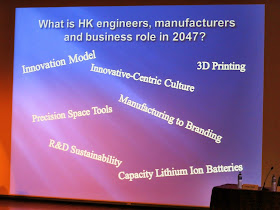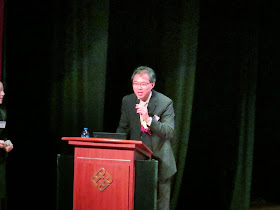In the beginning, Mr. Peter Fung (Vice-Chairman, HKSQ) presented the rules of the HKSQ Student Project Competition 2014 presentation. There were two topics as below:
Topic 1: To improve the process of turning collected food waste into high value animal feed.
Topic 2: To develop a method for effective collection and segregation of food waste so as to facilitate subsequent processes.
We invited three guests and two HKSQ exco members into our judge panel. They are Mr. Kwok Ming Cheung (Managing Director of Woodley Agri-Service Company Limited), Ms. Angela Wong (Exco member of HKSQ), Mr. Henry Ngai (CEO, HKOWRC), Mr. Eddie Chan (President, HKOWRC) and Dr. Aaron Tong (Former Chairman of HKSQ).
The first presentation team (Team B) was from CityU and they studied Topic 2. Six sigma DMAIC techniques were employed to analysis the problem.
Two things were bright included Compliment Label Scheme and self-made two-color separation design of Food Waste Storing Box.
The second presentation team (Team H) also come from PolyU and they studied Topic 1. They proposed to use microwave rapid drying machine turning the remained food into animal feed.
The third presentation team (Team G) was studied at PolyU and their study was in Topic 1. They proposed long-term solution such as “Green Pork”.
They also proposed to use Vibrated Fluidized Bed Dryer which provided gentle transportation by fluidization and vibration at 5-25 Hz, as well as, low gas rate chosen so that gas bubbling in the fluidized bed is avoided, generally reducing particle damages during to dry the food waste.
The fourth presentation team (Team D) was studied at CUHK and they studied the Topic 2. They proposed to use different color bins to collect meats, vegetables and cereals from kitchen and using cellulose to decompose food waste. They said “No Money No Talk, No Money No Action!”.
The fifth presentation team (Team A) was from CityU and their solution was for Topic 2. They suggested to use different color plastic bags to categorize types of food wastes.
They employed color separation smart camera to identify vegetable and other low protein value food. Moreover, they prepared short simulation video in Youtube.
The sixth presentation team (Team I) was from HKUST and they studied Topic 2 but they also mixed some part of Topic 1. Their presentation flow was Objective, Flow of our plan, logistics planning, segregation, black solider fly.
The logistics analysis was good in order to reduce the transportation fee.
Team E was the seventh presentation team from CUHK and they studied the Top 1 to produce high value animal feed from food waste. They benchmarked the dehydration technique from Sludge to Food Waste.
Team J was the eighth presentation team from HKUST and they selected Top 2 to develop a method for effective collection and segregation of food waste. They identified the problem to be low incentive because recycle food waste was costly but disposal was easy.
They suggested to use centrifuge principle for food waste processing and designed a downstream workflow.
The ninth presentation team (Team F) was from PolyU and their study was in the Topic 1 to improve the process of dehydration on food waste. They used cause and effect technique to identify the root cause.
They proposed the oil content modified design of the pipe for dehydration and made the prototype model.
Moreover, Team F had performed an experiment to confirm the efficiency.
The last presentation team (Team C) come from CityU and they studied on the Topic 2. They visited wet market and observed a large amount of well separated food waste.
After the judges discussion, Mr. Kwok Ming Cheung (Managing Director of Woodley Agri-Service Company Limited) and Mr. Eddie Chan (President, HKOWRC) gave short speeches to encourage student to think more about environmental and agriculture industries in Hong Kong.
The 2nd Runner Up was City University of Hong Kong (Team A).
The 1st Runner Up was The Hong Kong Polytechnic University (Team H).
The Champion was The Hong Kong Polytechnic University (Team F).
Then Mr. Kwok Ming Cheung sponsored one more prize as “Special Prize” (for 3rd Runner Up) to Team I from The Hong Kong University of Science and Technology.
Mr. Peter Fung represented HKSQ to present souvenir to Mr. Kwok Ming Cheung (Managing Director of Woodley Agri-Service Company Limited).
Mr. Peter Fung represented HKSQ to present souvenir to Mr. Eddie Chan (President, HKOWRC).
Before the end, we took a group photo.
During the judges discussion, we took a photo from different university for memory below.
City University of Hong Kong
The Hong Kong Polytechnic University
The Hong Kong University of Science and Technology
The Chinese University of Hong Kong
After the HKSQ Student Project Competition was completed successfully, we had dinner with sponsors.
Reference:
HKSQ Company Based Student Project Competition 2014 - http://www.hksq.org/company_based_competition.htm
20140215&22 - HKSQ Student Project Competition 2014 - Briefing & Plant Visit - http://qualityalchemist.blogspot.hk/2014/02/hksq-student-project-competition-2014.html
20140308 - Site Visit to Buddhist Chi King Primary School - http://qualityalchemist.blogspot.hk/2014/03/hksq-student-project-competition-2014.html
20140316 - Site Visit to Kee Wah Bakery - http://qualityalchemist.blogspot.hk/2014/03/hksq-student-project-competition-2014_16.html
























































